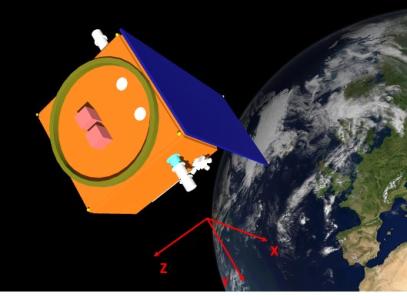Line of Sight Stabilisation Techniques
Programme
TDE
Programme Reference
T705-606SA
Prime Contractor
THALES ALENIA SPACE FRANCE
Start Date
End Date
Status
Closed
Country
France

Objectives
To provide Line of Sight stabilisation control technologies optimised for performance improvement, complexity reduction, and/or cost reduction at system level together with accurate guidelines for selection of the most relevant technologies as per mission definitions.
Description
For missions with demanding requirements in terms of pointing accuracy and pointing stability , many stabilisation technologies with different technology maturity are available. Those technologies can based on advanced control techniques for perturbations within or close to the Attitude and Orbital Control System (AOCS) control bandwidth (e.g. model based pre-compensation, local control loop of Solar Array Drive Mechanism). There are also some HardWare-based solutions such as passive damping of high frequency perturbation, active isolation at perturbation source level (e.g. cryo-cooler), reaction wheel optimisation, active control system inside the payload system (e.g. a Fast Steering Mirror, using platform sensor data. Those techniques have a significant impact in term of costs and complexity at system level (increased mass, power consumption, hardware development/qualification and complex and mission specific integration within the payload).
To complete these technology portforlio, new technologies based on digital stabilisation concept (e.g. lucky imaging) are foreseen to reduce these drawbacks, as this concept does not require additional actuators (especially when accommodated inside the Payload).
However, digital stabilisation technologies might also present some inherent drawbacks (e.g. imperfect compensation of the line of sight jitter). Depending on the missions definitions, the digital stabilisation shall be combined with ther others methods mentioned above. ;;Therefore, it is needed to map stabilisation techniques (including digital ones) to a large variety of missions (Earth Observation, Sciences, Low Earth Orbit to Geostationary Orbit, with/without appendages, etc.) considering key figures of merit (e.g. TRL, mass/volume, cost, complexity, performances, modularity and interaction with ground). Further development of the digital stabilisation technology are to be considered.
This activity encompasses the following tasks:
- analysis and definition of missions to select most relevant use case
- quantitative suitability analysis of the solutions to the selected missions
- preliminary assessment of the pointing performance ;of each suitable solution
- definition of detailed guidelines to select the optimised solution for a given mission definition
- identification and development of the digital stabilisation technology for the most relevant mission considering combined use with the other building blocks. This technology development includes as a minimum a preliminary system architecture definition, a design of digital algorithms, pointing, image quality and mission performance analysis based on the implemented digital algorithms.
Application Domain
Generic Technologies
Technology Domain
10 - Flight Dynamics and GNSS
Competence Domain
3-Avionic Systems
Initial TRL
TRL 2
Target TRL
TRL 4
Achieved TRL
TRL 3
Public Document
